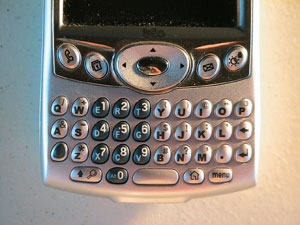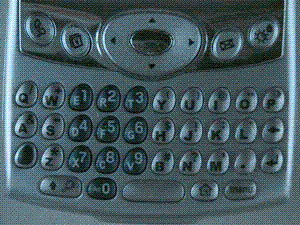 The Treo 600 has 3 distinct ways of entering data and navigating around the device. The built in keyboard provides an excellent way to enter data, while the 5-way navigator is an excellent implementation of one-handed navigation. If you prefer a more traditional method, a stylus is still in the device to use on the touch screen, though I personally prefer to use my fingernail. Missing is Graffiti 2, the software graffiti input system built into Palm OS 5.
The Treo 600 has 3 distinct ways of entering data and navigating around the device. The built in keyboard provides an excellent way to enter data, while the 5-way navigator is an excellent implementation of one-handed navigation. If you prefer a more traditional method, a stylus is still in the device to use on the touch screen, though I personally prefer to use my fingernail. Missing is Graffiti 2, the software graffiti input system built into Palm OS 5.
The Treo 600 keyboard is smaller than almost any other thumb board out there, but it still manages to allow for easy typing. It is a normal QWERTY keyboard, with the number keys on the left hand side. New to the Treo 600 is a dedicated home key - a much needed addition. The same list type feature that was invented with the Treo 180 is in the Treo 600, however the key has been renamed Alt. Screen brightness is also accessed from the keyboard. (Opt-P). If the nub over the 5 key isnt enough to help you find your way in the dark on the keyboard, the whole thing is also backlit. Its pretty cool, because (most) the keys are opaque silver under normal light, but when the blue-green backlight is turned on the light shines through the key clearly, with the actual lettering staying black. On the Sprint Treo 600, the key colors are reversed, with opaque black keys, and clear lettering.
 Typing on the new Treo thumb board takes some getting used to. The problem lies in the feedback that the keyboard gives to the user. On the original Treo, the keys were big enough that when you typed you could easily feel which key you pressed, and you got a little feedback from the keyboard when you typed. On the Treo 600, you still get the same accuracy, but when you type your thumb may cover up 5 keys, and while the Treo 600 somehow knows which key you wanted to type, you cant feel if you typed the correct key. It has made touch-typing on the Treo 600 slightly more difficult for me. Other than the lack of feedback from the keyboard, the Treo 600 keyboard is excellent. It is small enough that you can type one handed if needed, but is large enough to accommodate two thumbs racing along the keys. The keys feel solid, and easy to press. Handspring did a great job in keeping the keyboard as useable as the first generation Treos keyboards, while using much less space. What is interesting to note, that on my Rev. C. Sprint Treo 600, the keys do provide more feedback, it is unclear if this a change, or a fluke.
Typing on the new Treo thumb board takes some getting used to. The problem lies in the feedback that the keyboard gives to the user. On the original Treo, the keys were big enough that when you typed you could easily feel which key you pressed, and you got a little feedback from the keyboard when you typed. On the Treo 600, you still get the same accuracy, but when you type your thumb may cover up 5 keys, and while the Treo 600 somehow knows which key you wanted to type, you cant feel if you typed the correct key. It has made touch-typing on the Treo 600 slightly more difficult for me. Other than the lack of feedback from the keyboard, the Treo 600 keyboard is excellent. It is small enough that you can type one handed if needed, but is large enough to accommodate two thumbs racing along the keys. The keys feel solid, and easy to press. Handspring did a great job in keeping the keyboard as useable as the first generation Treos keyboards, while using much less space. What is interesting to note, that on my Rev. C. Sprint Treo 600, the keys do provide more feedback, it is unclear if this a change, or a fluke.
The 5-way navigator is what sets the Treo 600 apart in hardware from every other smartphone with a touch screen on the market. The button, oval to accommodate the thumb at an angle, is easy to use. The 4 direction keys move the focus, or scroll the screen, while the center button selects.  The 5-way navigator is only as good as the software that uses it, and Handspring again shows how well they can write software. Almost every built in app on the Treo 600 includes full support, with the best being from the phone app and in Blazer. The center button is also used to deactivate the key lock. Because of the five way navigator, in general use of the Treo 600 I found it much easier to not use the touch screen at all, and just move to where I want. The 5 way navigator is the feature that allows the Treo 600 to be used one handed without problem.
The 5-way navigator is only as good as the software that uses it, and Handspring again shows how well they can write software. Almost every built in app on the Treo 600 includes full support, with the best being from the phone app and in Blazer. The center button is also used to deactivate the key lock. Because of the five way navigator, in general use of the Treo 600 I found it much easier to not use the touch screen at all, and just move to where I want. The 5 way navigator is the feature that allows the Treo 600 to be used one handed without problem.
The Treo 600 still includes a stylus, though lightweight, small tiny stick would be a better description for it. The metal barrel with plastic tip design that Handspring first gave us with the Visor Deluxe lives on in the Treo 600. The small stylus can be forgiven though, because in normal use, the stylus is not that useful; I only used it for the reset pin in it. If, for some crazy reason you require Graffiti, while Handspring did not include it on the device, there are many third party apps that will re-enable it.
Next Page: The Camera >>